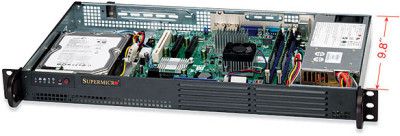From our front-page news:
Because we at Techgage cover desktop computing so heavily, it's easy to overlook the server side of things, which arguably, is just as large as desktop computing, if not larger. At the base of any company, large or small, there's likely one server, or a thousand, or tens of thousands. What that means for larger companies are unbelievable power bills, and it's no surprise... the computing power is huge.
Not all servers have got to be powerful enough to launch rockets, though. Take the latest offering from Supermicro, which instead of featuring the beefiest CPUs around, includes Intel's basic Atom processors. I've heard in the past that Atom actually serves as a good base for a simple server, and a release like this from one of the largest server providers pretty much confirms that.
Supermicro's more basic offering includes the single-core Atom 230, although a Dual-Core version is also available. The rackmount is smaller than 1U, with a depth of 9.8", and given the overall power consumption and thermal output, cooling would be rather quiet, as opposed to much larger servers. I have to admit, I absolutely love products like this. If more people used servers like this where applicable, the power saved would be immense... not only from the servers themselves, but from the cooling required to keep them operational.

Optimized for the single-core Atom 230 processor, which consumes only 4 watts of power, Supermicro's cost-effective X7SLA-L platform supports up to four SATA ports with RAID 0, 1, 5 and 10, along with seven USB 2.0 headers, 2 GB DDR2 memory, Intel GMA 950 graphics and a Gigabit Ethernet port. For more performance-intensive applications, the high-end X7SLA-H integrates the dual-core Atom 330 processor, which consumes 8 watts of power and expands upon the features of the X7SLA-L with dual Gigabit Ethernet ports, an additional onboard Type A USB 2.0 connector and an extra internal serial port.
Source: Supermicro, Via: TG Daily
Not all servers have got to be powerful enough to launch rockets, though. Take the latest offering from Supermicro, which instead of featuring the beefiest CPUs around, includes Intel's basic Atom processors. I've heard in the past that Atom actually serves as a good base for a simple server, and a release like this from one of the largest server providers pretty much confirms that.
Supermicro's more basic offering includes the single-core Atom 230, although a Dual-Core version is also available. The rackmount is smaller than 1U, with a depth of 9.8", and given the overall power consumption and thermal output, cooling would be rather quiet, as opposed to much larger servers. I have to admit, I absolutely love products like this. If more people used servers like this where applicable, the power saved would be immense... not only from the servers themselves, but from the cooling required to keep them operational.

Optimized for the single-core Atom 230 processor, which consumes only 4 watts of power, Supermicro's cost-effective X7SLA-L platform supports up to four SATA ports with RAID 0, 1, 5 and 10, along with seven USB 2.0 headers, 2 GB DDR2 memory, Intel GMA 950 graphics and a Gigabit Ethernet port. For more performance-intensive applications, the high-end X7SLA-H integrates the dual-core Atom 330 processor, which consumes 8 watts of power and expands upon the features of the X7SLA-L with dual Gigabit Ethernet ports, an additional onboard Type A USB 2.0 connector and an extra internal serial port.
Source: Supermicro, Via: TG Daily
